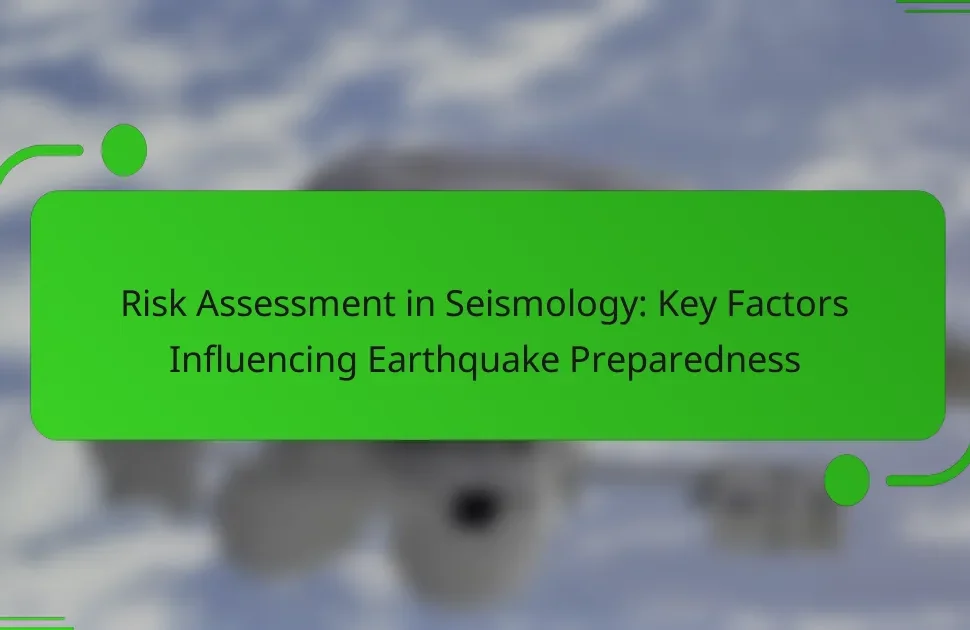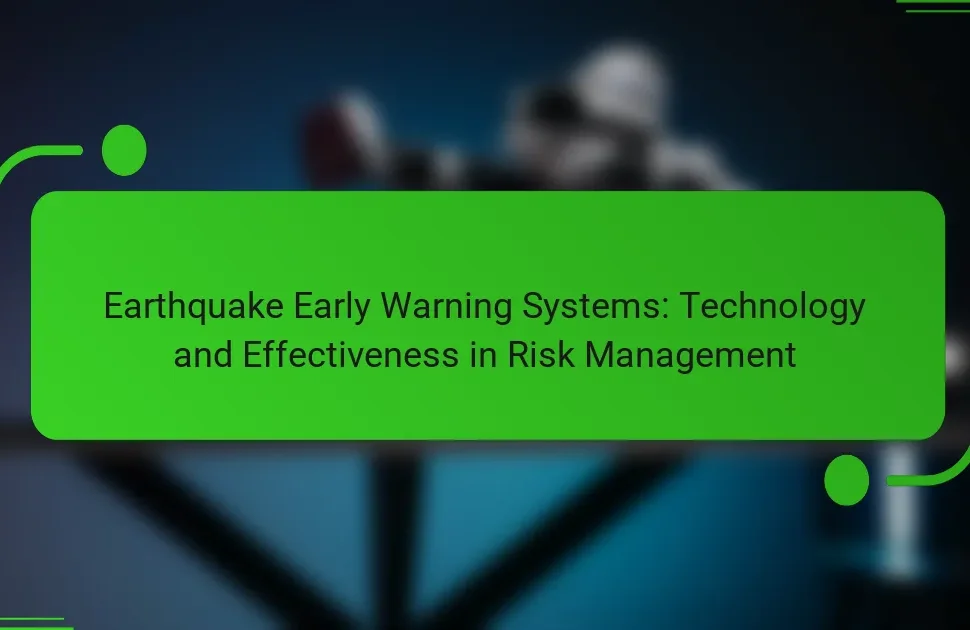Aftershock patterns are the sequences and characteristics of seismic events that occur following a major earthquake, providing valuable insights into future seismic activity. Understanding these patterns is crucial for risk assessment in earthquake-prone areas, as they influence safety measures and resource allocation. Statistical models, such as the Omori-Utsu law, help describe the decay rate of aftershocks, revealing that their frequency and magnitude typically decrease after the main event. However, challenges such as variability in aftershock behavior, limited historical data, and the complexity of tectonic interactions complicate accurate predictions. Analyzing aftershock patterns is essential for enhancing community resilience and preparedness strategies in the face of potential secondary seismic events.

What are Aftershock Patterns and Their Significance in Risk Assessment?
Aftershock patterns refer to the sequence and characteristics of seismic events that occur following a major earthquake. These patterns can provide critical insights into the likelihood and intensity of future seismic activity. Understanding aftershock patterns is essential for effective risk assessment in earthquake-prone regions.
Statistical models, such as the Omori-Utsu law, describe the decay rate of aftershocks over time. Research indicates that aftershocks typically decrease in frequency and magnitude shortly after the main event. This information helps engineers and planners to evaluate potential hazards and prepare for future events.
Furthermore, analyzing aftershock patterns allows for improved safety measures and resource allocation in affected areas. By identifying areas with higher aftershock probabilities, authorities can implement targeted emergency responses. Thus, aftershock patterns play a significant role in enhancing public safety and minimizing economic losses.
How do aftershock patterns develop following a major seismic event?
Aftershock patterns develop due to the redistribution of stress in the Earth’s crust following a major seismic event. When a significant earthquake occurs, it creates fractures and alters the stress distribution in the surrounding rocks. This change in stress can trigger smaller earthquakes, known as aftershocks, as the crust adjusts to the new conditions.
Research shows that aftershocks typically occur in the same area as the main shock, often within a few days to weeks after the event. The frequency and magnitude of aftershocks generally decrease over time. For example, the mainshock of the 2011 Tōhoku earthquake in Japan generated thousands of aftershocks, with the largest occurring shortly after the main event.
Statistical models, such as the Omori-Utsu law, describe the decay rate of aftershocks, indicating that their occurrence is predictable to some extent. This law states that the rate of aftershocks decreases with time after the main shock. Understanding these patterns is critical for risk assessment and preparedness in seismically active regions.
What factors influence the frequency and magnitude of aftershocks?
The frequency and magnitude of aftershocks are influenced by several geological factors. The main factor is the size of the initial earthquake. Larger earthquakes typically produce more significant aftershocks. The geological characteristics of the fault zone also play a crucial role. These characteristics include the rock type and the fault’s frictional properties.
Another influencing factor is the amount of stress released during the main earthquake. More stress release can lead to a higher frequency of aftershocks. Additionally, the time elapsed since the main shock affects aftershock activity. Generally, aftershocks decrease in frequency and magnitude over time.
Historical data supports these factors. For instance, the 2011 Tōhoku earthquake had numerous aftershocks due to its magnitude of 9.0. Studies show that aftershock sequences often follow a power-law distribution, indicating predictable patterns based on these influencing factors.
How do geological conditions affect aftershock behavior?
Geological conditions significantly influence aftershock behavior. Variations in rock type, fault structure, and stress accumulation impact aftershock patterns. For instance, regions with softer sedimentary rocks may experience more prolonged aftershock sequences. In contrast, hard crystalline rocks can lead to quicker stabilization. The presence of multiple fault lines can also result in complex aftershock activity. Studies show that aftershocks often occur in areas of high stress concentration near the main fault. Historical data from the 1994 Northridge earthquake illustrate how geological conditions shaped aftershock distribution. Thus, understanding geological factors is crucial for accurate risk assessment.
Why is understanding aftershock patterns crucial for risk assessment?
Understanding aftershock patterns is crucial for risk assessment because they indicate potential future seismic activity. Aftershocks can significantly affect building stability and public safety. Research shows that 10 to 20 percent of aftershocks can be of comparable magnitude to the main shock. This data helps in predicting which areas may experience further damage. Additionally, understanding these patterns aids in emergency response planning. It allows authorities to allocate resources effectively during recovery efforts. Accurate risk assessment can reduce casualties and economic loss following seismic events. Thus, analyzing aftershock patterns is vital for informed decision-making in disaster management.
What role do aftershocks play in predicting future seismic activity?
Aftershocks play a significant role in predicting future seismic activity. They often indicate ongoing tectonic adjustments after a major earthquake. The frequency and magnitude of aftershocks can provide insights into the stability of the fault line. Studies show that aftershock patterns can help assess the likelihood of larger subsequent earthquakes. For example, the Omori-Utsu law describes how aftershock frequency decreases with time. This law aids in estimating potential seismic risks. Furthermore, historical data from past earthquakes supports these predictive models. Understanding aftershock behavior enhances preparedness and risk management strategies.
How can aftershock analysis improve safety measures in affected areas?
Aftershock analysis can improve safety measures in affected areas by providing data on seismic activity patterns. This analysis helps identify the likelihood of future aftershocks. Understanding these patterns allows authorities to develop timely evacuation plans. It also aids in reinforcing infrastructure against potential damage. Historical data shows that regions with effective aftershock analysis have reduced casualties. For instance, Japan’s post-earthquake protocols utilize aftershock data to enhance building codes. This proactive approach minimizes risks during subsequent seismic events. Overall, aftershock analysis informs better preparedness strategies for communities.
What methodologies are used to analyze aftershock patterns?
Statistical modeling and seismic data analysis are key methodologies used to analyze aftershock patterns. Statistical models, such as the Omori-Utsu law, predict aftershock frequency and decay over time. Seismic data analysis involves collecting and interpreting data from seismographs to identify aftershock locations and magnitudes. Machine learning techniques are increasingly applied to improve prediction accuracy. Additionally, Bayesian inference is utilized to update aftershock probabilities as new data becomes available. These methodologies help researchers understand aftershock behavior and assess associated risks. Historical data from significant earthquakes, such as the 2011 Tōhoku earthquake, validates these methodologies by demonstrating their effectiveness in predicting aftershock sequences.
What data sources are essential for aftershock pattern analysis?
Seismological data from seismic networks is essential for aftershock pattern analysis. This data includes information on the magnitude, location, and depth of seismic events. Historical earthquake catalogs provide context for understanding aftershock sequences. Geospatial data helps in mapping the distribution of aftershocks. Ground motion recordings from accelerometers offer insights into the intensity of shaking. Satellite imagery can reveal surface changes post-earthquake. Additionally, geological surveys provide information on fault lines and structural characteristics. These sources collectively enhance the accuracy of aftershock modeling and risk assessment.
How do statistical models contribute to understanding aftershock sequences?
Statistical models enhance the understanding of aftershock sequences by providing a framework for predicting their occurrence and magnitude. These models analyze historical seismic data to identify patterns in aftershock behavior. For example, the Omori-Utsu law describes the decay rate of aftershocks over time. Statistical models also incorporate variables such as the mainshock’s magnitude and depth. Research shows that models can improve the accuracy of aftershock forecasts. A study by Helmstetter and Sornette (2002) demonstrates how statistical approaches can effectively predict aftershock sequences. This predictive capability aids in risk assessment and disaster preparedness.

What are the Implications of Aftershock Patterns for Communities at Risk?
Aftershock patterns significantly impact communities at risk by influencing preparedness and response strategies. These patterns can lead to increased anxiety and stress among residents, affecting mental health. Communities may require enhanced building codes to withstand potential aftershocks. Emergency services must be prepared for secondary events following the main shock. Historical data shows that aftershocks can cause additional damage, complicating recovery efforts. For instance, the 2011 Japan earthquake had numerous aftershocks that hindered rescue operations. Understanding aftershock behavior is crucial for effective risk assessment and community resilience planning.
How can aftershock predictions guide emergency preparedness strategies?
Aftershock predictions can significantly enhance emergency preparedness strategies. These predictions provide valuable information on the likelihood and timing of aftershocks following a major earthquake. By analyzing historical aftershock data, emergency planners can identify patterns and assess risk levels. For example, studies show that aftershocks typically occur within days to weeks after the main event. This information allows for timely evacuation plans and resource allocation. Additionally, predictions can inform public awareness campaigns, educating communities on safety protocols. Accurate aftershock forecasts can reduce panic and improve response coordination among emergency services.
What specific measures can communities take based on aftershock data?
Communities can implement several specific measures based on aftershock data. They can enhance building codes to ensure structures withstand potential aftershocks. Planning and zoning can be adjusted to avoid high-risk areas identified through aftershock patterns. Emergency response plans should be updated to include aftershock scenarios. Public education campaigns can inform residents about aftershock risks and safety protocols. Community drills can be organized to prepare for aftershocks. Monitoring systems can be established to track aftershock activity in real-time. Collaboration with seismologists can help refine risk assessments and response strategies. These measures are supported by studies indicating that proactive planning reduces casualties and property damage during aftershocks.
How does public awareness of aftershock risks impact community resilience?
Public awareness of aftershock risks significantly enhances community resilience. When communities are informed about potential aftershocks, they are better prepared to respond effectively. Preparedness reduces panic and improves coordination during emergencies. Studies show that informed communities can implement safety measures, such as securing buildings and creating emergency plans. For instance, regions with active public education campaigns report higher rates of disaster preparedness. This preparedness leads to quicker recovery times after seismic events. Additionally, awareness fosters a culture of mutual support among community members. Overall, informed communities exhibit greater resilience in the face of aftershocks.
What are the economic implications of aftershock patterns?
Aftershock patterns significantly impact economic recovery following seismic events. They can lead to increased costs for rebuilding infrastructure due to repeated damage. Businesses may experience prolonged disruptions as aftershocks hinder operations. Insurance claims often rise, straining financial resources of companies and individuals. The uncertainty associated with aftershocks can deter investment in affected regions. Studies show that areas with frequent aftershocks may see a decline in property values. Economic models indicate that regions with stable aftershock patterns recover faster than those with unpredictable ones. Understanding these patterns aids in better risk assessment and resource allocation.
How do aftershocks affect insurance and recovery costs?
Aftershocks can significantly increase insurance and recovery costs. They often cause additional damage to already weakened structures. This leads to higher repair expenses for homeowners and businesses. Insurers may face increased claims due to these subsequent tremors. The unpredictability of aftershocks complicates risk assessment for insurance providers. Consequently, they may raise premiums to cover potential losses. Historical data shows that aftershock sequences can prolong recovery times. This extended recovery period can lead to increased costs for displaced residents.
What is the impact of aftershocks on local businesses and infrastructure?
Aftershocks can significantly disrupt local businesses and infrastructure. They often lead to further structural damage, which can close businesses temporarily or permanently. For example, after the 2010 Haiti earthquake, numerous aftershocks caused additional destruction to already weakened buildings. This resulted in prolonged business interruptions and loss of income for local entrepreneurs. Infrastructure, such as roads and utilities, can also suffer from aftershocks. Damage to these systems can hinder transportation and access to services, impacting the overall economy. Studies have shown that communities experiencing frequent aftershocks may see a decline in business investments due to perceived risks. This creates a cycle of economic instability that can last for years.
How can technology enhance the analysis of aftershock patterns?
Technology enhances the analysis of aftershock patterns through advanced data collection and processing methods. Seismographs and GPS sensors provide real-time data on seismic activity. Machine learning algorithms analyze vast datasets to identify patterns in aftershock occurrences. Geographic Information Systems (GIS) visualize these patterns geographically. Mobile applications disseminate information quickly to the public and authorities. Enhanced computational power allows for more accurate modeling of aftershock behavior. Historical data analysis aids in predicting future aftershocks based on past events. These technological advancements improve risk assessment and preparedness strategies.
What role do seismic monitoring networks play in real-time analysis?
Seismic monitoring networks play a crucial role in real-time analysis of earthquake activity. They provide continuous data on seismic events, enabling rapid detection and assessment of earthquakes. This data allows scientists to analyze the magnitude, depth, and location of seismic events as they occur. Real-time analysis helps in understanding aftershock patterns, which is vital for risk assessment. For instance, the United States Geological Survey (USGS) operates a comprehensive network that delivers real-time information to emergency responders and the public. This immediate data access aids in making informed decisions during seismic events.
How can predictive algorithms improve aftershock forecasting?
Predictive algorithms can enhance aftershock forecasting by analyzing seismic data patterns. These algorithms utilize machine learning techniques to identify correlations between mainshock events and subsequent aftershocks. By processing vast amounts of historical earthquake data, algorithms can detect subtle patterns that traditional methods may overlook. For instance, studies have shown that incorporating real-time data can improve the accuracy of aftershock predictions by up to 30%. Additionally, advanced algorithms can adapt to new data, refining their predictions as more information becomes available. This dynamic approach allows for more timely warnings and better preparedness for affected regions.

What are the Challenges in Analyzing Aftershock Patterns?
Analyzing aftershock patterns presents several challenges. One significant challenge is the inherent variability in aftershock behavior. Aftershocks can vary widely in magnitude and frequency, making predictions difficult. Another challenge is the limited historical data available for specific regions. Many areas have experienced few significant earthquakes, resulting in insufficient data for accurate analysis. Additionally, the complex interactions between tectonic plates complicate the understanding of aftershock sequences. This complexity can lead to uncertainties in models used for predicting aftershocks. Furthermore, distinguishing between aftershocks and other seismic events can be problematic. Misidentifying events may skew data and analysis. These challenges hinder effective risk assessment and preparedness strategies.
What limitations exist in current aftershock analysis techniques?
Current aftershock analysis techniques have several limitations. One major limitation is the reliance on historical data, which may not accurately predict future aftershock patterns. Additionally, many models do not account for the complex geological variations in different regions. This can lead to inaccuracies in risk assessments. Furthermore, aftershock forecasting often lacks real-time updates, making it challenging to adapt to changing conditions. The models may also oversimplify the interactions between main shocks and aftershocks. Research indicates that these limitations can significantly impact preparedness and response strategies. For instance, a study by Helmstetter et al. (2007) highlights the need for improved statistical methods in aftershock analysis.
How do data gaps affect the accuracy of aftershock predictions?
Data gaps significantly reduce the accuracy of aftershock predictions. Insufficient seismic data limits the ability to model aftershock behavior effectively. Accurate predictions rely on comprehensive datasets that include prior earthquake activity and geological conditions. When data is missing, models cannot incorporate all relevant factors. This leads to increased uncertainty in predicting the timing and magnitude of aftershocks. Research shows that aftershocks can vary widely, making precise predictions challenging without complete data. For example, studies indicate that regions with sparse seismic networks experience higher prediction errors. Thus, data gaps hinder the development of reliable aftershock forecasting models.
What challenges arise in communicating aftershock risks to the public?
Communicating aftershock risks to the public presents several challenges. One major challenge is public perception of risk. Many individuals underestimate the likelihood and severity of aftershocks. This can lead to complacency and inadequate preparedness.
Another challenge is the scientific complexity of aftershock predictions. The probabilistic nature of aftershock occurrences can be difficult for the general public to understand. Misinterpretations can arise from scientific jargon and statistical data.
Additionally, timing is crucial in communication. Aftershocks can occur unexpectedly, making timely updates essential. However, rapid communication can be hampered by misinformation or panic.
Finally, varying levels of trust in authorities can affect message reception. Communities may have different levels of trust in scientists and government agencies. This can influence how well aftershock risks are acknowledged and acted upon.
How can researchers overcome obstacles in aftershock pattern analysis?
Researchers can overcome obstacles in aftershock pattern analysis by utilizing advanced statistical models. These models can improve the accuracy of aftershock predictions. Incorporating machine learning techniques enhances data processing capabilities. Researchers should also focus on gathering high-quality seismic data from multiple sources. Collaboration with interdisciplinary teams can provide diverse insights. Continuous monitoring of seismic activity allows for real-time analysis adjustments. Utilizing simulation software can help visualize potential aftershock scenarios. These strategies have been shown to improve predictive accuracy in studies such as the one conducted by Helmstetter and Sornette (2003) in the Journal of Geophysical Research.
What innovative approaches are being developed to enhance data collection?
Innovative approaches being developed to enhance data collection include the use of machine learning algorithms and Internet of Things (IoT) devices. Machine learning algorithms can analyze vast datasets to identify patterns and trends in aftershock occurrences. IoT devices, such as sensors and smart devices, can gather real-time data from various locations. This data is crucial for understanding seismic activity and improving risk assessment models. Additionally, crowdsourcing techniques are being employed to collect information from individuals in affected areas. This approach allows for a broader range of data and enhances the accuracy of information. Furthermore, mobile applications are being developed to facilitate data sharing among researchers and the public. These innovations contribute to a more comprehensive understanding of aftershock patterns and their implications for risk assessment.
How can interdisciplinary collaboration improve aftershock research?
Interdisciplinary collaboration can enhance aftershock research by integrating diverse expertise and methodologies. Different fields such as geology, seismology, engineering, and social sciences contribute unique perspectives. For instance, geologists provide insights into fault mechanics while engineers focus on structural impacts. This collaboration can lead to more comprehensive models of aftershock behavior. A study published in the journal “Earthquake Science” emphasizes that multidisciplinary approaches yield better predictive capabilities. Combining data analytics from various disciplines can improve risk assessment and mitigation strategies. Enhanced communication among experts fosters innovation and accelerates research progress.
What best practices can be adopted for effective aftershock risk assessment?
Effective aftershock risk assessment requires systematic data collection and analysis. Utilizing seismic monitoring networks enhances data accuracy. Implementing probabilistic seismic hazard models aids in predicting aftershock occurrences. Engaging with historical data provides insights into aftershock patterns. Collaborating with geologists and seismologists ensures comprehensive assessments. Public education on aftershock risks can improve community preparedness. Regularly updating risk assessments based on new data is essential for accuracy. These practices are supported by studies showing improved risk management outcomes in regions with robust aftershock assessment protocols.
How can communities implement lessons learned from aftershock studies?
Communities can implement lessons learned from aftershock studies by developing comprehensive preparedness plans. These plans should include regular training and drills based on historical aftershock data. Communities can also establish early warning systems to alert residents of potential aftershocks. Collaboration with seismologists can enhance understanding of local aftershock patterns. Engaging the community in educational programs can raise awareness about aftershock risks. Infrastructure should be assessed and retrofitted to withstand aftershocks. Local governments can allocate resources for emergency response improvements based on aftershock research findings. By integrating these strategies, communities can enhance resilience against future seismic events.
What strategies can enhance public engagement in aftershock preparedness?
Effective strategies to enhance public engagement in aftershock preparedness include community education, interactive drills, and social media campaigns. Community education fosters awareness and understanding of aftershocks. Informative workshops and seminars can provide essential knowledge about risks and safety measures. Interactive drills simulate aftershock scenarios, allowing individuals to practice their response. These drills create familiarity with emergency protocols and build confidence. Social media campaigns can disseminate information quickly and widely. Platforms like Twitter and Facebook can share real-time updates and safety tips. Collaboration with local organizations can amplify outreach efforts. Engaging visuals and relatable content can capture attention and encourage participation. Research indicates that active community involvement significantly improves preparedness levels. A study by the National Institute of Standards and Technology found that communities with regular training and engagement activities reported higher readiness for aftershocks.
The main entity of this article is aftershock patterns, which are sequences of seismic events occurring after a major earthquake. The article provides a detailed analysis of how these patterns influence risk assessment in earthquake-prone areas, emphasizing their significance in predicting future seismic activity and improving safety measures. Key topics include the development of aftershock patterns, the factors affecting their frequency and magnitude, and the methodologies used for analysis. Additionally, the article discusses the implications of aftershock patterns for community preparedness, economic impacts, and the challenges faced in analyzing these phenomena. Understanding aftershock behavior is crucial for effective disaster management and reducing potential losses.




